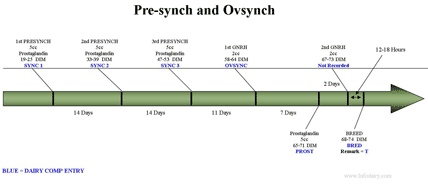Question of the month...

...We have been using the "Ovsynch" synchronization for our breeding program. We know farms that have good success with it, but we can't seem to make it work. We are thinking it may be related to the drugs we are using or semen or maybe the protocol, but we are not sure. Do you have any suggestions on how to find a solution?
...the following chart is a diagram of the "Pre-sync and Ovsynch" program from the InfoDairy management program used on many of the large dairies in the United States. There are several different variations of synchronization, but this is the most common, and proven very successful on many farms. Although there are a few cases of drug or semen issues, 95% of problems in synchronization problems are with compliance or management. Read the article below "5 reasons for Ovsynch failure" which will help you trouble shoot and find a solution to your reproduction problem.

5 Reasons for Ovsynch failure...

Synchronization programs are an excellent way to improve reproduction on your dairy. There are several different methods used, but the basic pre-sync / Ovsynch (7-2-1) has been shown by research to be the most effective. Although it is a successful method with a great deal of research behind it, it is also a method that can be very complex to even the most successful farms. As cow numbers increase, the need for a computer record keeping system is crucial. Success depends heavily on the management and monitoring weekly results. Several computer management software programs such as Dairy Comp 305 and Dairy Plan, now come with Ovsynch protocols built in to make record keeping more manageable. Below are the top 5 reasons for synchronization failure and also the 5 areas to investigate when looking to improve the success of the program. These items should be routinely reviewed by management to maintain and increase success of the program.
Read more 
Training - How to Dehorn calves

Dehorning calves is a common practice done on many dairy and beef farms all around the world. Dehorning is a simple and quick process and when done correctly, can prevent many future problems. When the horns are left on they...
- can cause more severe injury to other cattle, especially in corrals, feedlots and transport
- can damage hides and cause bruising which reduces the value of the meat and carcasses
- are harder to handle
- can be more dangerous to employees
- require more space at a feed bunk and on cattle trucks
- do not work well with head locks or modern milking parlors
- may suffer discounts at sale barns, especially if they are destined for feedlots
To learn how to properly dehorn calves and train your employees, see How to Dehorn Calves.
Dale Carnegie - Quote of the month...

“You have it easily in your power to increase the sum of this world's happiness now. How? By giving a few words of sincere appreciation to someone who is lonely or discouraged.”
It only takes a few short seconds for you to pass along a compliment or lend a helping hand. It does not benefit you to go through days, let alone weeks, without showing others appreciation or gratitude. Here are some tips on how to begin doing so:
- Smile
- Make the other person feel important, and do so with sincerity
- Offer honest appreciation
- Be a good listener, encourage others to talk about themselves
- Make it a point to give at least one compliment a day -- you may be surprised at how this simple act will improve your day, too
Newsletter Sponsor


|
